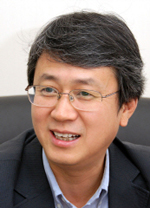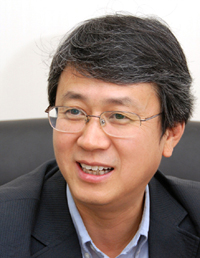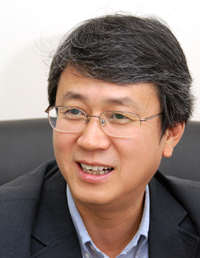Nano+Ceramics+Research+Lab
-
 Rechargeable Lithium Sulfur Battery for Greater Battery Capacity
Professor Do Kyung Kim from the Department of Material Science and Engineering and Professor Jang Wook Choi from the Graduate School of EEWS have been featured in the lead story of the renowned nanoscience journal Advanced Materials for their research on the lithium sulfur battery. This new type of battery developed by Professor Kim is expected to have a longer life battery life and [higher] energy density than currently commercial batteries.
With ample energy density up to 2100Wh/kg—almost 5.4 times that of lithium ion batteries—lithium sulfur batteries can withstand the sharp decrease in energy capacity resulting from charging and discharging—which has been considered the inherent limitation of the conventional batteries.
Professor Kim and his research team used one-dimensional, vertical alignment of 75nm tick, 15μm long sulfur nanowires to maximize electric conductivity. Then, to prevent loss of battery life, they carbon-coated each nanowire and prohibited direct contact between the sulfur and electrolyte.
The result was one of the most powerful batteries in terms of both energy performance and density. Compared to conventional batteries which suffer from continuous decrease in energy capacity after being discharged, the lithium sulfur battery maintained 99.2% of its initial capacity after being charged and discharged 300 times and up to 70% even after 1000 times.
Professor Kim claims that his new battery is an important step forward towards a high-performance rechargeable battery which is a vital technology for unmanned vehicles, electric automobiles and energy storage. He hopes that his research can solve the problems of battery-capacity loss and contribute to South Korea’s leading position in battery technology. Professor Kim’s research team has filed applications for one domestic and international patent for their research.
2013.12.11 View 13342
Rechargeable Lithium Sulfur Battery for Greater Battery Capacity
Professor Do Kyung Kim from the Department of Material Science and Engineering and Professor Jang Wook Choi from the Graduate School of EEWS have been featured in the lead story of the renowned nanoscience journal Advanced Materials for their research on the lithium sulfur battery. This new type of battery developed by Professor Kim is expected to have a longer life battery life and [higher] energy density than currently commercial batteries.
With ample energy density up to 2100Wh/kg—almost 5.4 times that of lithium ion batteries—lithium sulfur batteries can withstand the sharp decrease in energy capacity resulting from charging and discharging—which has been considered the inherent limitation of the conventional batteries.
Professor Kim and his research team used one-dimensional, vertical alignment of 75nm tick, 15μm long sulfur nanowires to maximize electric conductivity. Then, to prevent loss of battery life, they carbon-coated each nanowire and prohibited direct contact between the sulfur and electrolyte.
The result was one of the most powerful batteries in terms of both energy performance and density. Compared to conventional batteries which suffer from continuous decrease in energy capacity after being discharged, the lithium sulfur battery maintained 99.2% of its initial capacity after being charged and discharged 300 times and up to 70% even after 1000 times.
Professor Kim claims that his new battery is an important step forward towards a high-performance rechargeable battery which is a vital technology for unmanned vehicles, electric automobiles and energy storage. He hopes that his research can solve the problems of battery-capacity loss and contribute to South Korea’s leading position in battery technology. Professor Kim’s research team has filed applications for one domestic and international patent for their research.
2013.12.11 View 13342 -
 Method to Synthesize New Lithium Ion Battery Cathode Material Identified
A KAIST research team headed by Prof. Do-Kyung Kim at the Department of Materials Science and Engineering developed a technology to synthesize a new lithium ion battery spinel cathode which is regarded as a core part of hybrid and lithium battery cars.
The research was conducted in collaboration with a research team of Prof. Yi Cui at Stanford University"s Department of Chemistry. Their findings were introduced in the November issue of Nano Letters, one of the leading academic journals in nano-science.
The newly synthesized lithium ion battery spinel cathode known as spinel LiMn2O4 nanorods is attracting interests as an alternative cathode material since it is a low-cost, environmentally friendly substance for Li-ion battery cathodes. Its raw material is also highly available.
Lithium ion batteries with high energy and power density are important for consumer electronic devices, portable power tools, and vehicle electrification. LixCoO2 is a commonly used cathode material in commercial lithium iron batteries. However, the high cost, toxicity, and limited abundance of cobalt have been recognized to be disadvantageous.
2008.11.20 View 13653
Method to Synthesize New Lithium Ion Battery Cathode Material Identified
A KAIST research team headed by Prof. Do-Kyung Kim at the Department of Materials Science and Engineering developed a technology to synthesize a new lithium ion battery spinel cathode which is regarded as a core part of hybrid and lithium battery cars.
The research was conducted in collaboration with a research team of Prof. Yi Cui at Stanford University"s Department of Chemistry. Their findings were introduced in the November issue of Nano Letters, one of the leading academic journals in nano-science.
The newly synthesized lithium ion battery spinel cathode known as spinel LiMn2O4 nanorods is attracting interests as an alternative cathode material since it is a low-cost, environmentally friendly substance for Li-ion battery cathodes. Its raw material is also highly available.
Lithium ion batteries with high energy and power density are important for consumer electronic devices, portable power tools, and vehicle electrification. LixCoO2 is a commonly used cathode material in commercial lithium iron batteries. However, the high cost, toxicity, and limited abundance of cobalt have been recognized to be disadvantageous.
2008.11.20 View 13653 -
 KAIST Team Identifies Nano-scale Origin of Toughness in Rare Earth-added Silicon Carbide
A research team led by Prof. Do-Kyung Kim of the Department of Materials Science and Engineering of KAIST has identified the nano-scale origin of the toughness in rare-earth doped silicon carbide (RE-SiC), university sources said on Monday (Oct. 6).
The research was conducted jointly with a U.S. team headed by Prof. R. O. Ritchie of the Department of Materials Science and Engineering, University of California, Berkeley.
The findings were carried in the online edition of Nano Letters published by the American Chemical Association.
Silicon carbide, a ceramic material known to be one of the hardest substances, are potential candidate materials for many ultrahigh-temperature structural applications. For example, if SiC, instead of metallic alloys, is used in gas-turbine engines for power generation and aerospace applications, operating temperatures of many hundred degrees higher can be obtained with a consequent dramatic increase in thermodynamic efficiency and reduced fuel consumption. However, the use of such ceramic materials has so far been severely limited since the origin of the toughness in RE-SiC remained unknown thus far.
In order to investigate the origin of the toughness in RE-SiC, the researchers attempted to examine the mechanistic nature of the cracking events, which they found to occur precisely along the interface between SiC grains and the nano-scale grain-boundary phase, by using ultrahigh-resolution transmission electron microscopy and atomic-scale spectroscopy. The research found that for optimal toughness, the relative elastic modulus across the grain-boundary phase and the interfacial fracture toughness are the most critical material parameters; both can be altered with appropriate choice of rare-earth elements.
In addition to identifying the nano-scale origin of the toughness in RE-SiC, the findings also contributed to precisely predicting how the use of various rare-earth elements lead to difference in toughness.
University sources said that the findings will significantly advance the date when RE-SiC will replace metallic alloys in gas-turbine engines for power generation and aerospace applications.
2008.10.08 View 16387
KAIST Team Identifies Nano-scale Origin of Toughness in Rare Earth-added Silicon Carbide
A research team led by Prof. Do-Kyung Kim of the Department of Materials Science and Engineering of KAIST has identified the nano-scale origin of the toughness in rare-earth doped silicon carbide (RE-SiC), university sources said on Monday (Oct. 6).
The research was conducted jointly with a U.S. team headed by Prof. R. O. Ritchie of the Department of Materials Science and Engineering, University of California, Berkeley.
The findings were carried in the online edition of Nano Letters published by the American Chemical Association.
Silicon carbide, a ceramic material known to be one of the hardest substances, are potential candidate materials for many ultrahigh-temperature structural applications. For example, if SiC, instead of metallic alloys, is used in gas-turbine engines for power generation and aerospace applications, operating temperatures of many hundred degrees higher can be obtained with a consequent dramatic increase in thermodynamic efficiency and reduced fuel consumption. However, the use of such ceramic materials has so far been severely limited since the origin of the toughness in RE-SiC remained unknown thus far.
In order to investigate the origin of the toughness in RE-SiC, the researchers attempted to examine the mechanistic nature of the cracking events, which they found to occur precisely along the interface between SiC grains and the nano-scale grain-boundary phase, by using ultrahigh-resolution transmission electron microscopy and atomic-scale spectroscopy. The research found that for optimal toughness, the relative elastic modulus across the grain-boundary phase and the interfacial fracture toughness are the most critical material parameters; both can be altered with appropriate choice of rare-earth elements.
In addition to identifying the nano-scale origin of the toughness in RE-SiC, the findings also contributed to precisely predicting how the use of various rare-earth elements lead to difference in toughness.
University sources said that the findings will significantly advance the date when RE-SiC will replace metallic alloys in gas-turbine engines for power generation and aerospace applications.
2008.10.08 View 16387